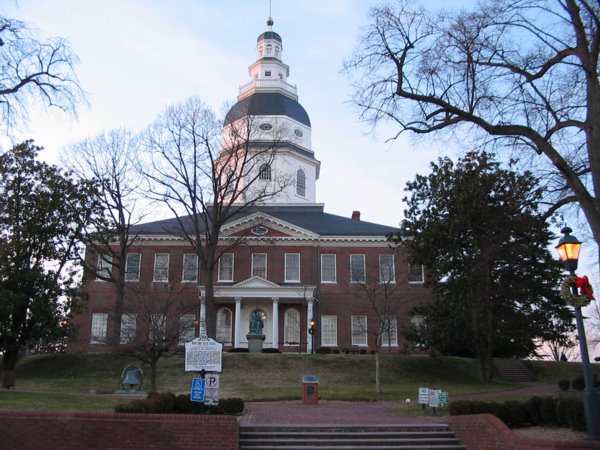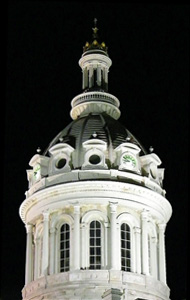“By the time I had put in new joists, new flooring, roof, and window sashes, it was virtually a new building except for the walls.”
--George A. Frederick
“The architect himself, held by a verbal agreement rather than written contract as was common in his profession, never received payment for working on the State House.”
—Archives of Maryland
The beautiful Maryland State House is the oldest state capitol still in continuous legislative use. It is the oldest and largest wooden dome of its kind in the United States. The Maryland State House was the first peacetime capitol of the United States and is the only state house ever to have served as the nation's capitol.
The Maryland Board of Public Works hired Frederick in 1877 to design the repairs to the State House in Annapolis as he was likely working at Lind & Murdoch when they worked on the octagonal library in the State House in 1858. In 1876 Governor Groome signed into law an act appropriating $32,000 for the repairs. After a year of delays, Frederick was finally instructed to contract with various builders in April 1877. Once work began, Frederick and the Board quickly realized that the building was in much worse condition than imagined. Once the building was stripped to address these repairs and install heating, it needed to be plastered and painted. Though the original intention had been to preserve the Senate Chamber and other historic rooms in their original Revolutionary appearance, as Groome testified on behalf of the Board of Public Works, having redone the entire building it would seem awkward to simply put back the old furniture. “We could have finished in a plain, simple and Quaker-like way,” he said, “But…if we did the work slovenly and in a plain manner, we did not think we would be justified in exceeding the appropriation.”
And they certainly exceeded the appropriation. The budget of $32,000 more than tripled to $111,388.29. In 1878 the House of Delegates appointed a Select Committee to Investigate the Repairs upon the State House. They heard testimony from the Board of Public Works, Frederick and all contractors involved in the repairs. After concluding that it was not the 1876 Legislature’s fault for appropriating so little money—they had no way of knowing the extent of the building's damage—and pardoning the Board of Public Works for simply insuring the safety of elected officials, the Select Committee placed blame squarely on the architect, George Frederick. While the government officials were not to blame for failing to realize the magnitude of the repairs until the building was torn apart, Frederick should not have put in such a low bid. The Committee questioned both the Board and Frederick on the 5% commission for the project, implying that he added costs in order to raise his compensation. Frederick later claimed that he worked harder on the State House project than any other in his life. As with the House of Correction, Frederick made sure his contractors were paid in full for their time and materials. The architect himself, held by a verbal agreement rather than written contract as was common in his profession, never received payment for working on the State House.
The Maryland State House was designated a National Historic Landmark by the Department of the Interior in July 1968.
Here's a link to an article regarding the state house's restoration in 2012. |


